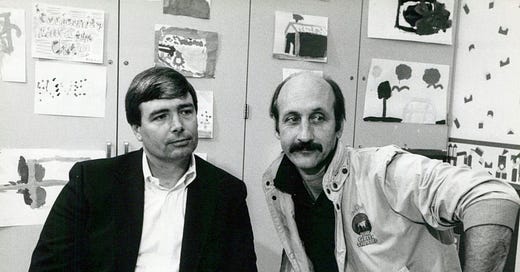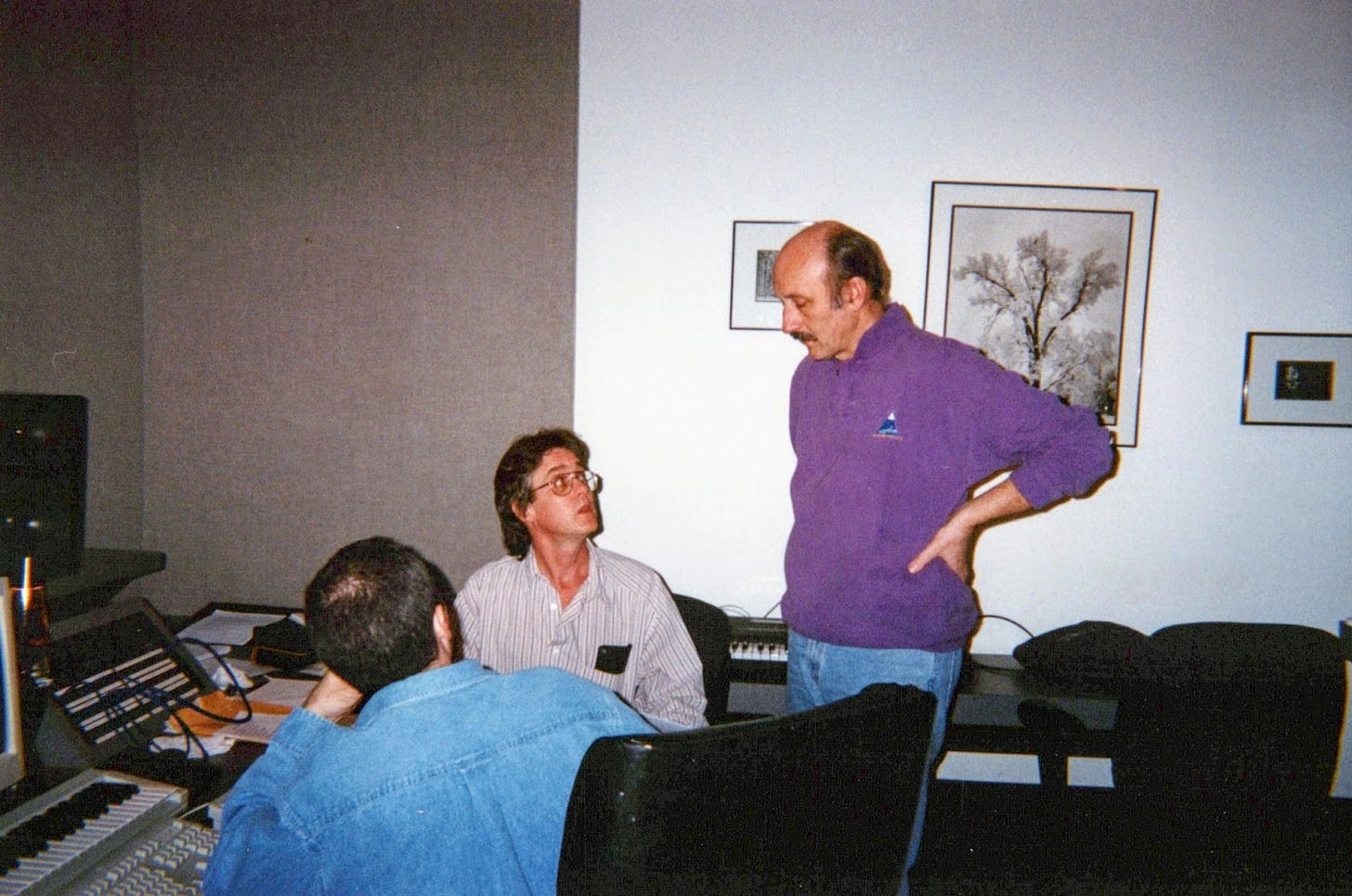Jim Newton & Noel in a hospital playroom for a CBS Morning Program “shoot”(1987)
When Noel and I began working on his autobiography, I had no idea about his involvement with a nonprofit that provides “therapeutic music entertainment” for children. I was even more surprised to learn that the founder of the organization was Jim Newton, a singer / songwriter whom I had met at a 1988 national campus ministry gathering. At that time Jim was traveling around the country performing for church youth groups and college campus ministries. I was so impressed with his music that I invited him to sing at James Madison University in Harrisonburg, Virginia, where I was a campus minister. I bought one of his albums to share with my 8-year-old daughter. Little did I know then that Jim and I would meet again nearly thirty years later.
Both Jim and I had spent most of our working lives “beyond the local church,” United Methodist Church jargon for the placement of ministers who were not pastors. Jim had gone to seminary at Perkins of Theology at Southern Methodist University, taking courses in clinical pastoral education (CPE), and preparing to become a chaplain or a licensed pastoral counselor. But instead of following that path after graduation, he started a band that played in churches, campus ministries and clubs. To support and guide his work as an itinerant musician, he founded a nonprofit called Celebration Shop.
A typical weekend for Jim during this time was to perform an evening concert, spend Saturday with a youth group, and sing in Sunday morning worship. But on one of these visits to a church in Columbus, Ohio, he was asked by his host family if he would do just one more thing. They explained that during their child’s long fatal illness, they had grown close to the nurses and children in a pediatric unit of the local hospital. Would Jim visit the unit and sing for the children on Sunday afternoon before his flight back to Dallas?
This was his last gig of a long tour, and he was tired and out of sorts. He reluctantly agreed, but his heart was not in it. He had, in his words, “a bad attitude and no kid’s material.” Still, somehow he managed to find the energy to sing a few songs for the group of children gathered in the fifth floor waiting area. But as he was packing up his guitar, a nurse asked him to visit a little boy named Toby in still in his room becaause wasn’t physically able to join the other kids.
Toby and his mother were sitting on Toby’s bed when Jim opened the door. Jim took out his guitar, played a few chords, sang a song but got no response. Deciding that one song was not enough, he began another. Halfway through the second song, Toby began to smile and eventually clap his hands. As Jim was leaving, Toby’s mother walked with him out the door and said, “Toby hasn’t smiled like that in weeks, and he’s never before clapped his hands to music.” She added, “I don’t think we’re going to be able to take him home. Thank you for this priceless gift.”
Jim says, “A light bulb went off in my head. In spite of my poor efforts, lack of material and lack of a good attitude, the need was so great for this little boy and his mom that my music made a difference. I thought maybe I should focus my pastoral care and chaplaincy training on music for kids who are in hospitals.” At the next meeting of the Celebration Shop board he told the members that he wanted to begin moving his music into children’s hospitals. During several years of transitioning from music for churches and campus ministries into what is officially called “therapeutic musical entertainment,” Jim and the Celebration Shop board identified two important needs. One was changing their nonprofit name to the more kid-friendly “Hugworks.” The other was to find a top-notch music producer. Months later when Noel was in Dallas with PP&M, Jim told Noel about Toby and the beginnings of his hospitalized children’s music project. Moved by Jim’s story, Noel said yes.
Paul Hill was a graduate of SMU with degree in music theory and composition. Both he and Jim had previously worked together in church settings and more recently as therapeutic music entertainers for hospitalized children When Noel joined Hugworks in 1985 as a singer, songwriter, and producer, one of the first songs to be recorded was Paul Hill’s piece “Inside,” encouraging self-esteem. Its message is based on the adage “you can't judge a book by its cover,” and as Noel has said (most recently in Larry Dykstra’s Music on a Mission: The Story of KidLinks), “The songs that Jim and Paul have either created or chosen to perform are songs that focus on our mutual well-being, delivered in a language that speaks with a sense of respect to the child within each of us.”
Paul Hill and Noel in studio (1988)
“Inside” became one of the songs on the first Hugworks album, as well as one of the tunes on the Peter, Paul and Mommy Too album released in 1993. Initially included on a cassette titled Friends of the Family (which later became a CD called Best I Can Be), it was the beginning of a nearly forty years of Noel’s collaboration with Paul and Jim in the studio.
When Jim, Paul, and Noel were planning their second album We Can Do, J.W. Brown—a Dallas investment banker and longtime supporter of Jim’s work—not only made a large contribution, but also persuaded his associates in the energy industry to cover the rest of the cost. J.W. also initiated the formation a 501(c)3 nonprofit called The KidLinks Foundation in 2001, which provides funding for over half of the Kidlinks’ budget through two yearly events, the KidLinks Energy Golf Classic and the Symphony of Chefs, a dinner for which chefs from restaurants in the Dallas area cook at individual donor tables. In 2015 Hugworks merged with the KidLinks Foundation and became KidLinks. A digital platform, originally called Hugworks Children’s Network (HCN), was launched shortly after, offering free access to songs and animations. In 2016 Kidlinks added a streaming Music Therapy channel, and in 2018, to avoid confusion, the Hugworks name was dropped, and the platform became known as KidLinks.
KidLinks songs address the emotional needs of hospitalized children This method of writing lyrics is a reversal of the usual process of songwriting, in which the songwriter starts with something personal and hopes the song will connect with an audience. In contrast, KidLinks songs are written to meet such emotional needs as competence, self-esteem, fear of abandonment, fear of medical procedures, hopelessness, guilt and loneliness. They have brought hope and healing to thousands of hospitalized children and their families and reached many more through KidLinks online presence.
Connections:
Check out the KidLinks website.
Discover the difference between Therapeutic Music Entertainment and Music Therapy.
Larry Dykstra’s Music on a Mission: The Story of KidLinks (2022) details the inspirational story and work of KidLinks.
Vibrations:
Hear the KidLinks version of “Inside,” and see the Peter, Paul, and Mommy Too recording here.
Resonance:
Explore some of the songs on the KidLinks website, select a favorite, and tell us about your response to it.






I liked “All in Your Backyard.” It celebrated creepy, crawly insects that are delightful and yet are often scorned. It also encourages to enjoy what they can discover just outside their door, “in their own backyard.” Even if you live in the city, you don’t have to drive miles to explore the gifts of creation.
.......i forwarded a child brain institute link to you.